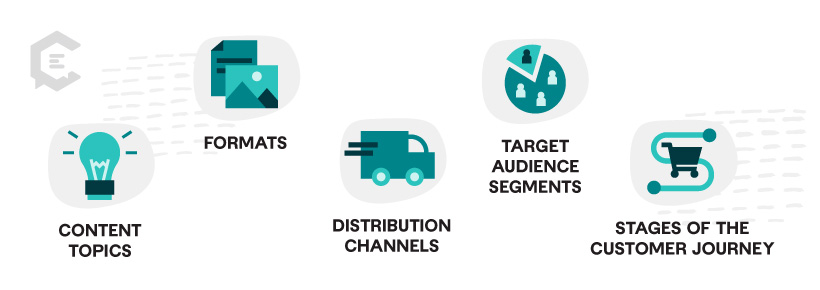What is a content matrix?
A content matrix is a visual aid that organizes your content based on two dimensions: where it falls in the conversion funnel and what tactic it uses to reach the target audience. Content matrixes are powerful tools for developing a high-level marketing strategy and assessing its execution.
These guides ensure that content is diverse, well-targeted, and covers relevant topics across different platforms and stages.

A content matrix typically consists of a table or spreadsheet format that categorizes content based on the following:
- Content topics
- Formats
- Distribution channels
- Target audience segments
- Stages of the customer journey
The first axis of the matrix measures where along the conversion process, a piece of content falls. On one end, you have the initial awareness stage. On the other, you have the final conversion. The second axis measures how a given piece of content resonates with its audience. On one side, you have a purely emotional approach. On the other, an entirely rational one.
Combining the two and plotting your existing content onto the matrix gives you a comprehensive visual breakdown of your content marketing funnel.
In the quadrant of the content matrix that’s toward the emotional end of the spectrum and early on the conversion funnel, you might see viral video content. In the highly rational quadrant and at the end of your conversion funnel, you might see testimonials touting the benefits of your product or service.
Why is creating a content matrix so important?
A content matrix is a helpful framework for assessing your content and planning where to take it in the future. You can locate weak spots, highlight strengths, and make sure you’re emphasizing the content areas that best resonate with your audience.
Using this matrix ensures better content variety and balance. You can identify content gaps and diversify your content offerings by categorizing content based on different criteria. This approach keeps the audience engaged, accommodates different preferences, and allows for targeted content delivery.
What can you do with a content matrix?
A content matrix is a simple tool with a wide range of effective uses.
Identify content gaps
The content matrix can identify content gaps in your existing strategy. Use it to look for areas where you have limited or no content coverage. This can help you diversify your content offerings and address your audience’s missing needs or interests.
Plan content campaigns
The content matrix can clarify when executing a new campaign. Start by Identifying a specific theme, topic, or objective, then map out the content that aligns with that campaign goal. Using the content matrix ensures a cohesive and consistent message throughout the campaign, increasing its impact and engagement.
Experiment with different content formats
Experimentation is necessary to keep your marketing strategies ahead of trends. It is much easier to play around with new ideas when you have a clear guide to help you visually map them out.
Leverage different distribution channels
A content matrix can help you determine which distribution channels are most effective for reaching your target audience. This can include social media platforms, email newsletters, guest blogging, industry publications, or collaboration with influencers or partners.
Map content to different buyer journey stages
You can create content that targets each stage by aligning your content matrix with the various stages of the buyer’s journey. You can offer educational content to build awareness, informative content to aid consideration, and persuasive content to support decision-making.
Incorporate user-generated content
Incorporate more personalized content for your audience using the content matrix to integrate user-generated content. This increases engagement and adds authenticity and credibility to your content.
Collaborate with influencers or industry experts
You can use the content matrix to identify collaboration opportunities with influencers or industry experts. The matrix can assist in planning content pieces that involve guest contributions, interviews, or expert insights. These collaborations can expand your reach, tap into new audiences, and bring fresh perspectives to your content.
Examples of a Content Matrix
Smart Insights
Smart Insights’ content matrix is broken into four quadrants to help you create your own: Entertain (quizzes and branded videos), inspire (community forums and celebrity endorsements), educate (articles and infographics), and convince (interactive demos and webinars).
Send Pulse
This content matrix example by Send Pulse goes more in-depth by breaking it into awareness, consideration, decision, and after-purchase quadrants, with content filled out for pain points, solutions, content assets, and CTAs to move down the funnel.
Orbit Media
Orbit Media’s content marketing matrix focuses on content performance. The quadrants are broken up into Polish (add CTAs, internal links, and videos), pursue (repeat with the same time, same format, etc.), pass (try something else), and promote (email, share, write, link).
If you’ve completed your content matrix and identified gaps, ClearVoice can help. Talk to a content specialist today about getting high-performing content created for your brand, from blog posts and white papers to social content and eBooks.





